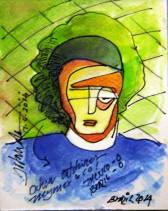
In honor of today’s match—at once startling and completely predictable—I share Ángel Zárraga’s gorgeous 1927 portrait of Ramón Novarro as a futbolista. Novarro (who moved to Los Angeles early in his career) was one of the original Latin Lovers. He starred in Scaramouche (1923), Ben Hur (1925), and Mata Hari (1931). He played Juan Diego in La virgen que forjó una patria (1942), a film celebrating one of Mexico’s origin stories: the appearance of the Virgin of Guadalupe to Diego in 1531. Diego was beatified and canonized only recently; he is the first indigenous person in the Americas to be recognized by the Roman Catholic church as a saint. But I digress.
Ramón Novarro was gay, and he was murdered in Los Angeles by two (white) men on, of all things, October 30, 1968 – the day before Halloween and Day of the Dead celebrations. The murder was a grisly, awful affair.
This brings us to today’s match. The ESPN broadcast opened with an awkward explanation of the “puto” situation. It was, perhaps, the first trigger warning issued in sports broadcast history.
Fans of El Tri shout “PUTO” every time the opponent kicks a dead ball (goal kicks, free kicks, etc.). After Mexico’s first match, a watchdog organization filed a complaint with FIFA regarding the use of the word by fans in the stands. FIFA, unable to use the word “homophobic” in a sentence, decided that the chant is “not considered insulting in this context.” Obviously it is insulting; the question is whether “puto” is homophobic. No one can defend the word itself as never homophobic. Juliana Jimenez Jamarillo (writing for Slate) explains:
Fans yell puto, which roughly means gay prostitute, at the opposing team’s goalkeeper as a tactic to distract him from his task, a common enough practice in all sports. In this case, the chant is a very specific, homophobic double-entendre, playing on the concept of letting someone “score a goal on you.” In Spanish, to score a goal is meter un gol. That translates literally as to put a goal in, so when a goalie fails at his job, he dejó que se la metieran, or allowed someone to stick it in. You see where this is going: The embarrassment of allowing a goal in your net is akin to being on the receiving end of anal sex—you know, like a gay guy. (Jamarillo, “What’s the Puto Problem?”)
There wasn’t much anyone could do, ESPN host Bob Ley explained. The feed isn’t controlled by ESPN, and who can control fans? (One might say FIFA—they bans drums and trumpets and changed Brazilian law so that alcohol—Budweiser!—might be sold in the stadium.)
Lest we shrug off a stadium of (mostly) men shouting “puto” as merely a jinx on the opponent, let us remember gay men who have been brutally murdered at the hands of other men. Maybe by inviting men into their homes, or maybe by simply walking down the street.
For a couple weeks, we have listened to tens of thousands of fans chanting a word that means gay, but also “fucked.” And we’ve had little good commentary about how that situation is fucked up. It isn’t new (I’ve heard “puto” at Chivas USA matches, for example), but that doesn’t make it OK. Behind that word are quite specific histories of violence, aimed at quite specific people.
Also not new—Mexico fans exiting, with their team, at exactly this point of the World Cup.
Were I in the stands supporting El Tri, I might choose a different word when taunting the enemy. Not only for how “puto” works in a homophobic lexicon, but for how well it predicts Mexico’s path through every international tournament. If understanding the word’s homophobic resonances does not work for fans, perhaps a vocabulary shift might be made in the name of superstition.




 Soccer is a dialogic sport. It is shaped by opposition and struggle, by action and counteraction. There are no absolutes in these kinds of sports. The things that make for a great match, for example, are not the same things that make for a great race. A race is structured by a standard measurement of time, as well as by the idea of absolute performance (“the fastest human”). But a match is measured by the quality of the conversation.
Soccer is a dialogic sport. It is shaped by opposition and struggle, by action and counteraction. There are no absolutes in these kinds of sports. The things that make for a great match, for example, are not the same things that make for a great race. A race is structured by a standard measurement of time, as well as by the idea of absolute performance (“the fastest human”). But a match is measured by the quality of the conversation.











